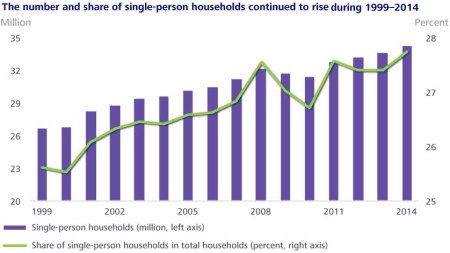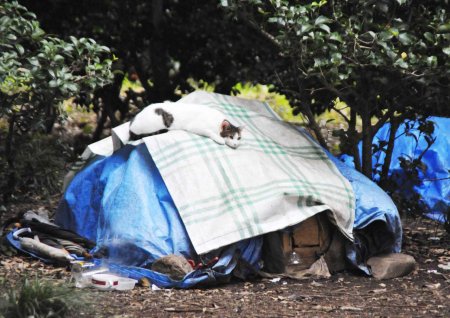When the Beatles released their album Sgt. Pepper’s Lonely Hearts Club Band in 1967, it was praised as the elevation of pop music to the level of fine art and as the first concept album. The album was for 15 weeks number one in the USA and it got four Grammy awards.
The music was an eclectic mixture of styles ranging from rock and pop to vaudeville, jazz, classical, and Indian music. The lyrics were ambiguous and cryptic. There are hints about drug use but also references to non-violence and peace. Not only the title, but most of the lyrics are about human relations, alienation, social isolation, and loneliness.
A year earlier, the Beatles had released the song Eleanor Rigby, whose lyrics are also about loneliness and desolation. This song broke crucial pop music conventions but nevertheless topped the charts and it has since been covered by many other artists.
Reading the lyrics of the Sgt. Pepper album again, a few are mediocre, but most are creative, even ingenious. No matter if the overriding theme of loneliness was an intuitive or conscious choice, it was appropriate, because loneliness is an important issue, is a part of the human condition. The Beatles were not the first songwriters to address it and loneliness is not a modern phenomenon, it existed since the start of time, well documented in art, oral tradition, and literature.

Throughout history people were stigmatized because of disabilities, because of their appearance, because of sickness, because they misbehaved, committed a crime, or just because of bad luck. Miscreants, misfits, dissidents, heretics were expelled from their communities and had to live alone, shunned by their fellow humans. Living alone was not the worst what could have happened to them, in the Middle Ages right up to modern times many elderly lone women were accused to be witches and burned alive on the stake, together with their beloved cats, the trusting creatures who had made their loneliness bearable.
The need for social interaction differs individually and in all ages there were introverted people who preferred to live alone, retreating into a hermitage or a monastery. Young men wandered from town to town as journeymen, others were minstrels, there were beggars, poachers, robbers who lived alone or in temporary loose groups. Aristocratic loners lived on their rural estates, only confronted with their maids and butlers.
Loneliness is clearly not a new phenomenon and there are countless examples of famous persons who lived secluded, some by their own choice, others forced into isolation by poverty or social norms.
Famous persons who lived alone:
Composer Antonio Vivaldi, an ordained priest, lived alone, as did Ludwig van Beethoven, who courted many woman but was never successful because of his status as a commoner.
Painter Henri de Toulouse-Lautrec lived alone. His stunted legs prevented him to find a wife, and he died in poverty from complications of alcoholism and syphilis.
The philosopher Henry David Thoreau stated: “I find it wholesome to be alone the greater part of the time. … I never found the companion that was so companionable as solitude”. Thoreau never married and his sexuality, or lack of, has been the subject of speculation.
Isaac Newton, one of the greatest scientists who ever lived, was never married or engaged and it is widely believed that he died as a virgin.
The legendary inventor Nikola Tesla never married or had any known intimate contact. He said: “I do not think there is any thrill that can go through the human heart like that felt by the inventor… such emotions make a man forget food, sleep, friends, love, everything.” Tesla died impoverished and alone in a New York hotel room.
Oscar Wilde, who was homosexual, died aged 46, penniless and alone in Paris from cerebral meningitis.
Glenn Gould, a renowned Canadian pianist and composer, lived a solitary existence, though Friends described him as warm and charming. Gould died of a stroke in 1982.
Greta Garbo, a Swedish actress who made 28 films during her acting career lived for 50 years right till her death alone in New York.
“The trouble is not that I am single and likely to stay single, but that I am lonely and likely to stay lonely.”
Charlotte Bronte
Though there are many historic examples of loners, hermits, outsiders, lone wolfs, both anecdotal evidence and solid statistics suggest that the number of people who live alone is increasing in the last decades and more people than ever feel unhappy and suffer from loneliness.
Single households in Europe have doubled in the last thirty years and the trend is mirrored in all industrial countries around the world. According to the market research firm Euromonitor International, the number of people living alone globally rose from 153 million in 1996 to 277 million in 2011 — an increase of around 80 percent in 15 years. In Britain, single households have risen to 34 percent, in the USA the number is 27 percent.
In 1950, 22 percent of US adults were single, Four million lived alone, accounting for 9 percent of all households. Today, 32 million are single and the typical US-American will spend more of her or his adult life unmarried than married, and for much of this time will live alone.
The majority of singles in the USA are women (18 million, compared to 14 million men). 16 million singles are middle-aged adults between 35 and 64, 11 million are elderly, young adults between 18 and 34 number 5 million and are the fastest-growing segment of the solo-dwellers. People who live alone cluster together in metropolitan areas.

Sweden has with 47 percent more singles than any other country, followed by Norway with 40 percent (in Scandinavian countries the welfare state protects citizens from the more difficult aspects of living alone). Even in Japan, where social life has historically been organized around the family, 30 percent of all households are single, and the rate is far higher in urban areas. The nations with the fastest growth of one-person households are China, India, and Brazil.
“Loneliness is never more cruel than when it is felt in close propinquity with someone who has ceased to communicate.”
Germaine Greer
In 1949, Yale anthropologist George Peter Murdock surveyed some 250 cultures across history and geography, to conclude:
The nuclear family is a universal human social grouping. Either as the sole prevailing form of the family or as the basic unit from which more complex familial forms are compounded, it exists as a distinct and strongly functional group in every known society. No exception, at least, has come to light.
This survey and other related scientific research suggest, that the increase in single households is against human nature, is an aberration. More about that later in the text.
“Sometimes I feel like nobody even knows I exist.”
Unknown
Why do people live alone?
There are several reasons:
1. The media (movies, TV, social media sites, romantic novels) raise unrealistic expectations and depict an easy and clean world. Movies and TV-shows tell stories of perfect partners and perfect love, and we go out trustingly looking for the person of our dreams, the one who will fulfill all the expectations that we ever had in life, the one with whom we will realize our deepest wishes and aspirations, only to be disappointed again and again until the harsh reality sinks in and we understand that the perfect mate doesn’t exist.
An additional impediment are the standards set by advertising. People buy designer cloth, follow trends, modes, fashions, and think that makes them precious and adorable. They regard themselves more attractive as they appear to other persons and reject applicants who they deem as unworthy, while persons who are supposedly in their class will in turn reject them as unworthy.
2. The Internet and social media sites have allowed people to experience social life even when they’re living alone. This is though the online variety of social life, or a virtual social life, while “real” social life is out of reach, because after spending most of their time with electronic communication people have lost the ability to interact with other persons face to face. An estimated 10 percent of Internet users have become so obsessed with online activities that their real (offline) social relationships are declining and endangered.
As more and more people feel lonely, dating services, especially online dating services have jumped in to the rescue. These services are not charity organizations, they maximize their profit not by matching people fast and straightforward, but by fueling illusions and keeping the customers searching as long as possible. People use these services often for several years, spending significant sums just to nurture the illusion that one day they will find the perfect spouse.
3. Western consumer society has increased individualism and egoism. Everybody thinks her or his way of life is the best possible and people who don’t conform with the standards of consumer society are viewed as misfits.
In the end, giving the choice of living ones accustomed life undisturbed or breaking with the past and starting a new life together, learning everything new together, many opt to stay alone, thereby avoiding the annoyance of a spouse constantly disrupting their familiar routines.
People are also not used to share and to cooperate and that makes it difficult for them to share and cooperate in a partnership. Without sharing and cooperation the relation will fail, but people will not blame themselves, they will blame their partner or the whole opposite gender. “Men are all the same — don’t even try.”
Advertising tells us that shopping and buying solves all our needs. This is one of the core dogmas (or doctrines) of consumerism, which has become the eminent religion of our time. But shopping and buying doesn’t work for love. One can buy a “trophy wife,” a mail-order bride, a mistress, a prostitute, but one cannot buy love.
4. Increased affluence makes it less necessary to found a family, stay together, and weather the storms of life together. Women in Western Europe don’t need a man to support them because the welfare system guarantees them a steady income and they can live a comfortable (though modest) life even without working. Many people are gaming the welfare system, but at the moment the affluent European nations still can pay the bill.
People live alone because they can afford it and they cocoon in their homes which they have furnished and equipped according to their individual needs. They create their own reality fueled by carefully selected videos and music.
The longer they stay alone the harder it is for them to change established routines, habits, make the compromises that are necessary if a pair lives together in a shared household.

5. Mass urbanization has shattered traditional social bonds and friendships. A hectic urban lifestyle, characterized by sensory overstimulation (overload), multitasking, by the anonymity of automatized mass services and supply systems (supermarkets) makes it impossible to sense and perceive the subtle signs and signals which help to start intimate personal relations.
6. The decline of traditional family values has lifted the social pressure to marry and live together in a family. Women are less discriminated and feel less social pressure to gain social acceptance by marriage. More women are working and favor their career over family life. Men on the other hand feel not anymore the moral obligation to marry the woman they have impregnated and support the child they have fathered.
7. Older men who want to find a woman are confronted with the biological fact that many women after menopause have a reduced or no sexual desire. These men of course would like to have a younger woman, but in a social climate and a popular culture where youthfulness is cherished and older people are despised or stigmatized, they are not attracting any women.
Rich men like George Soros, Rupert Murdoch, Donald Trump, David Siegel didn’t have difficulties to find a young woman, but the average guy over 50 will be dissed and ridiculed by young girls, if he dares to court and woo them. The best he can hope for is to be regarded as a “Sugar Daddy.”

Living alone and feeling lonely is not necessarily the same but there are indications that the increase in single households is paralleled by an increase of people who suffer from loneliness. Loneliness appears to have intensified in every society in the world as modernization occurs.
A 2006 study in the American Sociological Review found that US-Americans on average had only two close friends in which to confide, which was down from an average of three in 1985. The percentage of people who noted having no such confidant rose from 10 to almost 25 percent.
US surveys show that Women are lonelier than men (though unmarried men are lonelier than unmarried women). African Americans are lonelier than whites. The less educated are lonelier than the better educated. The unemployed and the retired are lonelier than the employed.
The pain of loneliness
“What should young people do with their lives today? Many things, obviously. But the most daring thing is to create stable communities in which the terrible disease of loneliness can be cured.”
Kurt Vonnegut
Loneliness has also been described as social pain — a psychological mechanism meant to alert an individual of isolation and motivate her / him to seek social connections. Loneliness is neurological similar to pain, as the experience of being rejected activates the dorsal anterior cingulate cortex, a part of the brains that also is activated when the body feels physical pain.
University of Chicago psychologist John Cacioppo has written a book titled “Loneliness,” where he shows that the need for social connection is so fundamental in humans that without it we get sick and fall apart, down to the cellular level.
Loneliness, Cacioppo argues, isn’t a personality defect or sign of weakness — it’s a survival impulse like hunger or thirst, a trigger pushing us toward the nourishment of human companionship. Loneliness was a powerful evolutionary force binding prehistoric people to those they relied on for food, shelter, and protection, to help them raise their young and carry on their genetic legacy. The distress that our ancestors felt if they were separated from their group served as a warning to reengage or else perish.
Natural selection favored people who needed people. Compared to the big predators, Humans were small and weak and they only could fight off the beasts in a concerted effort. To raise children, with their slow-maturing cerebral cortexes, mothers needed help from the tribe. These are the main reasons why humans are social mammals.

There are individual differences though and personal characteristics such as introversion and neuroticism are strongly related to loneliness. A longtime study of twins found evidence that genetic disposition account for approximately half of the differences in loneliness.
John Cacioppo estimates, that 20 percent of US-Americans, about 60 million people, suffer from loneliness that is chronic and harms their health.
Loneliness has been linked with depression, and is thus a risk factor for suicide; it is known to increase the concentration of cortisol levels in the body, it causes high blood pressure, high cholesterol, obesity, neurodegenerative diseases, even cancer.
A team of researchers, including Cacioppo, has recently published a study showing loneliness actually triggers cellular changes that cause illness. The study offers an in-depth look at how a fight-or-flight stress signaling initiates a snowball effect that ultimately alters the production of monocytes (a type of white blood cells). White blood cells are normally the guards who fight off infection, however, an inappropriate inflammatory response (aka a non-reciprocated influx of white blood cell activity) can actually do more harm than good if not regulated.
This phenomenon, known as CTRA (conserved transcriptional response to adversity), leaves lonely individuals more vulnerable to infection due to dampened antiviral response, and also more susceptible to chronic disease thanks to the inappropriate inflammation. Some of these potential health consequences include heart disease and stroke, increased stress levels, decreased memory and learning, alcoholism, and altered brain function. Because loneliness disrupts the regulation of cellular processes in the body, it also predisposes those suffering from it to premature aging.
According to another study, published in the journal Cortex, lonely people’s brains differ from those of non-lonely people, as regions that make them highly vigilant become more active in social situations. When people feel socially isolated, their brains automatically switch into self-preservation mode, making them more abrasive and defensive in the face of supposed social danger.
A third study, published in the journal Trends in Cognitive Sciences, found that when people felt lonely their brains became more active in response to images of another person in distress. Their brains also became less activated in an area involved with understanding others people’s emotions and recognizing situations from the others perspectives.
Such changes will start a “vicious circle,” because people who feel isolated are fearful of bad social experiences, lose faith that it is possible to find friends or a spouse, and subsequently become even more isolated.
German psychoanalyst Frieda Fromm-Reichmann predicted these scientific findings already in the late 50s, more than a half-century ago. One of the first to examine social isolation from an empirical perspective, she wrote in her 1959 essay “On Loneliness,” that “the naked horror of loneliness shadows our lives because the longing for intimacy is always with us.”
“The eternal quest of the individual human being is to shatter his loneliness.”
Norman Cousins
Conclusions
What conclusion can be made from all this?
One possible conclusion is, that life is dreadful anyway and we just have to bear it stoically following the wisdom of Epictetus or gathering strength from the teachings of Buddha (“Life is suffering,” the starting point of the four noble truth of Buddhism).
Yet, neither the Stoics nor Buddha didn’t mean that, aside from the necessity to accept the inevitable, we shouldn’t change for the better what we can change. In regard to the problem of loneliness, much of it is self-inflicted and much can be avoided if only we take the effort, end our lethargy, overcome our timidity.
Society is the sum of all individuals, our very own conduct constitutes the social climate. We don’t have to wait for government programs, we can start right now with our personal plan, reaching out either to end our own loneliness or to help lonely people around us break their isolation. If we are rejected, we have to find out why, speak with people, argue with them, understand them.
Some persons may try to hurt us, cheat us, exploit us, which shouldn’t be surprising in a society based on competition and financial success. The cheaters will hurt themselves the most, being limited to their cliques of fellow cheaters and conmen, having to watch their back all the time, deprived of true friendship, kindness, grace.
We may contact friends and acquaintances via telecommunication but we have to meet them in person. Only personal contact will give us social experience, will increase our social skills, will tell us the essence of human nature.

If everything else fails, if everyone around you seems to be busy, disturbed, petrified, and you cannot penetrate their armor of social isolation, there is still one lovely solution:
Go to the animal asylum and look for the cats (it has to be cats of course because this blog is “for the critical thinking cat lover”). They are waiting for you, they are desperate to find a human friend who will give them shelter, food, love, security. They will look at you with appreciation, maybe meow desperately and press their little snouts against the grid.
Don’t take the pretty one, take the ugly one, because this cat will not easily find a host. This is the cat that most likely will adore you and will be grateful and love you with every piece of her / his little heart. This is the cat who will wait for you when you come home and be joyous and meow as loud as she or he can. Maybe you can accommodate even two cats, so that they are not alone when you are away.
Your little friend will accompany you hopefully for many years, will be the light of your life, teach you compassion, kindness, tenderness. Maybe one day a human friend will come along, it is not impossible, you are open and prepared, your feline companion has taught you what to do, has taught you how to give love and receive love.
Related:Do you need a friend?

The music was an eclectic mixture of styles ranging from rock and pop to vaudeville, jazz, classical, and Indian music. The lyrics were ambiguous and cryptic. There are hints about drug use but also references to non-violence and peace. Not only the title, but most of the lyrics are about human relations, alienation, social isolation, and loneliness.
A year earlier, the Beatles had released the song Eleanor Rigby, whose lyrics are also about loneliness and desolation. This song broke crucial pop music conventions but nevertheless topped the charts and it has since been covered by many other artists.
Reading the lyrics of the Sgt. Pepper album again, a few are mediocre, but most are creative, even ingenious. No matter if the overriding theme of loneliness was an intuitive or conscious choice, it was appropriate, because loneliness is an important issue, is a part of the human condition. The Beatles were not the first songwriters to address it and loneliness is not a modern phenomenon, it existed since the start of time, well documented in art, oral tradition, and literature.

Throughout history people were stigmatized because of disabilities, because of their appearance, because of sickness, because they misbehaved, committed a crime, or just because of bad luck. Miscreants, misfits, dissidents, heretics were expelled from their communities and had to live alone, shunned by their fellow humans. Living alone was not the worst what could have happened to them, in the Middle Ages right up to modern times many elderly lone women were accused to be witches and burned alive on the stake, together with their beloved cats, the trusting creatures who had made their loneliness bearable.
The need for social interaction differs individually and in all ages there were introverted people who preferred to live alone, retreating into a hermitage or a monastery. Young men wandered from town to town as journeymen, others were minstrels, there were beggars, poachers, robbers who lived alone or in temporary loose groups. Aristocratic loners lived on their rural estates, only confronted with their maids and butlers.
Loneliness is clearly not a new phenomenon and there are countless examples of famous persons who lived secluded, some by their own choice, others forced into isolation by poverty or social norms.
Famous persons who lived alone:
Composer Antonio Vivaldi, an ordained priest, lived alone, as did Ludwig van Beethoven, who courted many woman but was never successful because of his status as a commoner.
Painter Henri de Toulouse-Lautrec lived alone. His stunted legs prevented him to find a wife, and he died in poverty from complications of alcoholism and syphilis.
The philosopher Henry David Thoreau stated: “I find it wholesome to be alone the greater part of the time. … I never found the companion that was so companionable as solitude”. Thoreau never married and his sexuality, or lack of, has been the subject of speculation.
Isaac Newton, one of the greatest scientists who ever lived, was never married or engaged and it is widely believed that he died as a virgin.
The legendary inventor Nikola Tesla never married or had any known intimate contact. He said: “I do not think there is any thrill that can go through the human heart like that felt by the inventor… such emotions make a man forget food, sleep, friends, love, everything.” Tesla died impoverished and alone in a New York hotel room.
Oscar Wilde, who was homosexual, died aged 46, penniless and alone in Paris from cerebral meningitis.
Glenn Gould, a renowned Canadian pianist and composer, lived a solitary existence, though Friends described him as warm and charming. Gould died of a stroke in 1982.
Greta Garbo, a Swedish actress who made 28 films during her acting career lived for 50 years right till her death alone in New York.
“The trouble is not that I am single and likely to stay single, but that I am lonely and likely to stay lonely.”
Charlotte Bronte
Though there are many historic examples of loners, hermits, outsiders, lone wolfs, both anecdotal evidence and solid statistics suggest that the number of people who live alone is increasing in the last decades and more people than ever feel unhappy and suffer from loneliness.
Single households in Europe have doubled in the last thirty years and the trend is mirrored in all industrial countries around the world. According to the market research firm Euromonitor International, the number of people living alone globally rose from 153 million in 1996 to 277 million in 2011 — an increase of around 80 percent in 15 years. In Britain, single households have risen to 34 percent, in the USA the number is 27 percent.
In 1950, 22 percent of US adults were single, Four million lived alone, accounting for 9 percent of all households. Today, 32 million are single and the typical US-American will spend more of her or his adult life unmarried than married, and for much of this time will live alone.
The majority of singles in the USA are women (18 million, compared to 14 million men). 16 million singles are middle-aged adults between 35 and 64, 11 million are elderly, young adults between 18 and 34 number 5 million and are the fastest-growing segment of the solo-dwellers. People who live alone cluster together in metropolitan areas.

Sweden has with 47 percent more singles than any other country, followed by Norway with 40 percent (in Scandinavian countries the welfare state protects citizens from the more difficult aspects of living alone). Even in Japan, where social life has historically been organized around the family, 30 percent of all households are single, and the rate is far higher in urban areas. The nations with the fastest growth of one-person households are China, India, and Brazil.
“Loneliness is never more cruel than when it is felt in close propinquity with someone who has ceased to communicate.”
Germaine Greer
In 1949, Yale anthropologist George Peter Murdock surveyed some 250 cultures across history and geography, to conclude:
The nuclear family is a universal human social grouping. Either as the sole prevailing form of the family or as the basic unit from which more complex familial forms are compounded, it exists as a distinct and strongly functional group in every known society. No exception, at least, has come to light.
This survey and other related scientific research suggest, that the increase in single households is against human nature, is an aberration. More about that later in the text.
“Sometimes I feel like nobody even knows I exist.”
Unknown
Why do people live alone?
There are several reasons:
1. The media (movies, TV, social media sites, romantic novels) raise unrealistic expectations and depict an easy and clean world. Movies and TV-shows tell stories of perfect partners and perfect love, and we go out trustingly looking for the person of our dreams, the one who will fulfill all the expectations that we ever had in life, the one with whom we will realize our deepest wishes and aspirations, only to be disappointed again and again until the harsh reality sinks in and we understand that the perfect mate doesn’t exist.
An additional impediment are the standards set by advertising. People buy designer cloth, follow trends, modes, fashions, and think that makes them precious and adorable. They regard themselves more attractive as they appear to other persons and reject applicants who they deem as unworthy, while persons who are supposedly in their class will in turn reject them as unworthy.
2. The Internet and social media sites have allowed people to experience social life even when they’re living alone. This is though the online variety of social life, or a virtual social life, while “real” social life is out of reach, because after spending most of their time with electronic communication people have lost the ability to interact with other persons face to face. An estimated 10 percent of Internet users have become so obsessed with online activities that their real (offline) social relationships are declining and endangered.
As more and more people feel lonely, dating services, especially online dating services have jumped in to the rescue. These services are not charity organizations, they maximize their profit not by matching people fast and straightforward, but by fueling illusions and keeping the customers searching as long as possible. People use these services often for several years, spending significant sums just to nurture the illusion that one day they will find the perfect spouse.
3. Western consumer society has increased individualism and egoism. Everybody thinks her or his way of life is the best possible and people who don’t conform with the standards of consumer society are viewed as misfits.
In the end, giving the choice of living ones accustomed life undisturbed or breaking with the past and starting a new life together, learning everything new together, many opt to stay alone, thereby avoiding the annoyance of a spouse constantly disrupting their familiar routines.
People are also not used to share and to cooperate and that makes it difficult for them to share and cooperate in a partnership. Without sharing and cooperation the relation will fail, but people will not blame themselves, they will blame their partner or the whole opposite gender. “Men are all the same — don’t even try.”
Advertising tells us that shopping and buying solves all our needs. This is one of the core dogmas (or doctrines) of consumerism, which has become the eminent religion of our time. But shopping and buying doesn’t work for love. One can buy a “trophy wife,” a mail-order bride, a mistress, a prostitute, but one cannot buy love.
4. Increased affluence makes it less necessary to found a family, stay together, and weather the storms of life together. Women in Western Europe don’t need a man to support them because the welfare system guarantees them a steady income and they can live a comfortable (though modest) life even without working. Many people are gaming the welfare system, but at the moment the affluent European nations still can pay the bill.
People live alone because they can afford it and they cocoon in their homes which they have furnished and equipped according to their individual needs. They create their own reality fueled by carefully selected videos and music.
The longer they stay alone the harder it is for them to change established routines, habits, make the compromises that are necessary if a pair lives together in a shared household.

5. Mass urbanization has shattered traditional social bonds and friendships. A hectic urban lifestyle, characterized by sensory overstimulation (overload), multitasking, by the anonymity of automatized mass services and supply systems (supermarkets) makes it impossible to sense and perceive the subtle signs and signals which help to start intimate personal relations.
6. The decline of traditional family values has lifted the social pressure to marry and live together in a family. Women are less discriminated and feel less social pressure to gain social acceptance by marriage. More women are working and favor their career over family life. Men on the other hand feel not anymore the moral obligation to marry the woman they have impregnated and support the child they have fathered.
7. Older men who want to find a woman are confronted with the biological fact that many women after menopause have a reduced or no sexual desire. These men of course would like to have a younger woman, but in a social climate and a popular culture where youthfulness is cherished and older people are despised or stigmatized, they are not attracting any women.
Rich men like George Soros, Rupert Murdoch, Donald Trump, David Siegel didn’t have difficulties to find a young woman, but the average guy over 50 will be dissed and ridiculed by young girls, if he dares to court and woo them. The best he can hope for is to be regarded as a “Sugar Daddy.”

Living alone and feeling lonely is not necessarily the same but there are indications that the increase in single households is paralleled by an increase of people who suffer from loneliness. Loneliness appears to have intensified in every society in the world as modernization occurs.
A 2006 study in the American Sociological Review found that US-Americans on average had only two close friends in which to confide, which was down from an average of three in 1985. The percentage of people who noted having no such confidant rose from 10 to almost 25 percent.
US surveys show that Women are lonelier than men (though unmarried men are lonelier than unmarried women). African Americans are lonelier than whites. The less educated are lonelier than the better educated. The unemployed and the retired are lonelier than the employed.
The pain of loneliness
“What should young people do with their lives today? Many things, obviously. But the most daring thing is to create stable communities in which the terrible disease of loneliness can be cured.”
Kurt Vonnegut
Loneliness has also been described as social pain — a psychological mechanism meant to alert an individual of isolation and motivate her / him to seek social connections. Loneliness is neurological similar to pain, as the experience of being rejected activates the dorsal anterior cingulate cortex, a part of the brains that also is activated when the body feels physical pain.
University of Chicago psychologist John Cacioppo has written a book titled “Loneliness,” where he shows that the need for social connection is so fundamental in humans that without it we get sick and fall apart, down to the cellular level.
Loneliness, Cacioppo argues, isn’t a personality defect or sign of weakness — it’s a survival impulse like hunger or thirst, a trigger pushing us toward the nourishment of human companionship. Loneliness was a powerful evolutionary force binding prehistoric people to those they relied on for food, shelter, and protection, to help them raise their young and carry on their genetic legacy. The distress that our ancestors felt if they were separated from their group served as a warning to reengage or else perish.
Natural selection favored people who needed people. Compared to the big predators, Humans were small and weak and they only could fight off the beasts in a concerted effort. To raise children, with their slow-maturing cerebral cortexes, mothers needed help from the tribe. These are the main reasons why humans are social mammals.

There are individual differences though and personal characteristics such as introversion and neuroticism are strongly related to loneliness. A longtime study of twins found evidence that genetic disposition account for approximately half of the differences in loneliness.
John Cacioppo estimates, that 20 percent of US-Americans, about 60 million people, suffer from loneliness that is chronic and harms their health.
Loneliness has been linked with depression, and is thus a risk factor for suicide; it is known to increase the concentration of cortisol levels in the body, it causes high blood pressure, high cholesterol, obesity, neurodegenerative diseases, even cancer.
A team of researchers, including Cacioppo, has recently published a study showing loneliness actually triggers cellular changes that cause illness. The study offers an in-depth look at how a fight-or-flight stress signaling initiates a snowball effect that ultimately alters the production of monocytes (a type of white blood cells). White blood cells are normally the guards who fight off infection, however, an inappropriate inflammatory response (aka a non-reciprocated influx of white blood cell activity) can actually do more harm than good if not regulated.
This phenomenon, known as CTRA (conserved transcriptional response to adversity), leaves lonely individuals more vulnerable to infection due to dampened antiviral response, and also more susceptible to chronic disease thanks to the inappropriate inflammation. Some of these potential health consequences include heart disease and stroke, increased stress levels, decreased memory and learning, alcoholism, and altered brain function. Because loneliness disrupts the regulation of cellular processes in the body, it also predisposes those suffering from it to premature aging.
According to another study, published in the journal Cortex, lonely people’s brains differ from those of non-lonely people, as regions that make them highly vigilant become more active in social situations. When people feel socially isolated, their brains automatically switch into self-preservation mode, making them more abrasive and defensive in the face of supposed social danger.
A third study, published in the journal Trends in Cognitive Sciences, found that when people felt lonely their brains became more active in response to images of another person in distress. Their brains also became less activated in an area involved with understanding others people’s emotions and recognizing situations from the others perspectives.
Such changes will start a “vicious circle,” because people who feel isolated are fearful of bad social experiences, lose faith that it is possible to find friends or a spouse, and subsequently become even more isolated.
German psychoanalyst Frieda Fromm-Reichmann predicted these scientific findings already in the late 50s, more than a half-century ago. One of the first to examine social isolation from an empirical perspective, she wrote in her 1959 essay “On Loneliness,” that “the naked horror of loneliness shadows our lives because the longing for intimacy is always with us.”
“The eternal quest of the individual human being is to shatter his loneliness.”
Norman Cousins
Conclusions
What conclusion can be made from all this?
One possible conclusion is, that life is dreadful anyway and we just have to bear it stoically following the wisdom of Epictetus or gathering strength from the teachings of Buddha (“Life is suffering,” the starting point of the four noble truth of Buddhism).
Yet, neither the Stoics nor Buddha didn’t mean that, aside from the necessity to accept the inevitable, we shouldn’t change for the better what we can change. In regard to the problem of loneliness, much of it is self-inflicted and much can be avoided if only we take the effort, end our lethargy, overcome our timidity.
Society is the sum of all individuals, our very own conduct constitutes the social climate. We don’t have to wait for government programs, we can start right now with our personal plan, reaching out either to end our own loneliness or to help lonely people around us break their isolation. If we are rejected, we have to find out why, speak with people, argue with them, understand them.
Some persons may try to hurt us, cheat us, exploit us, which shouldn’t be surprising in a society based on competition and financial success. The cheaters will hurt themselves the most, being limited to their cliques of fellow cheaters and conmen, having to watch their back all the time, deprived of true friendship, kindness, grace.
We may contact friends and acquaintances via telecommunication but we have to meet them in person. Only personal contact will give us social experience, will increase our social skills, will tell us the essence of human nature.

If everything else fails, if everyone around you seems to be busy, disturbed, petrified, and you cannot penetrate their armor of social isolation, there is still one lovely solution:
Go to the animal asylum and look for the cats (it has to be cats of course because this blog is “for the critical thinking cat lover”). They are waiting for you, they are desperate to find a human friend who will give them shelter, food, love, security. They will look at you with appreciation, maybe meow desperately and press their little snouts against the grid.
Don’t take the pretty one, take the ugly one, because this cat will not easily find a host. This is the cat that most likely will adore you and will be grateful and love you with every piece of her / his little heart. This is the cat who will wait for you when you come home and be joyous and meow as loud as she or he can. Maybe you can accommodate even two cats, so that they are not alone when you are away.
Your little friend will accompany you hopefully for many years, will be the light of your life, teach you compassion, kindness, tenderness. Maybe one day a human friend will come along, it is not impossible, you are open and prepared, your feline companion has taught you what to do, has taught you how to give love and receive love.
Related:Do you need a friend?

Keine Kommentare:
Kommentar veröffentlichen